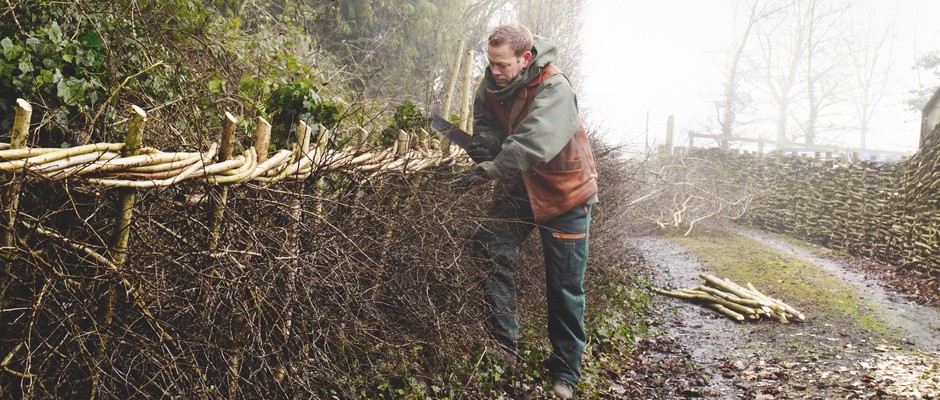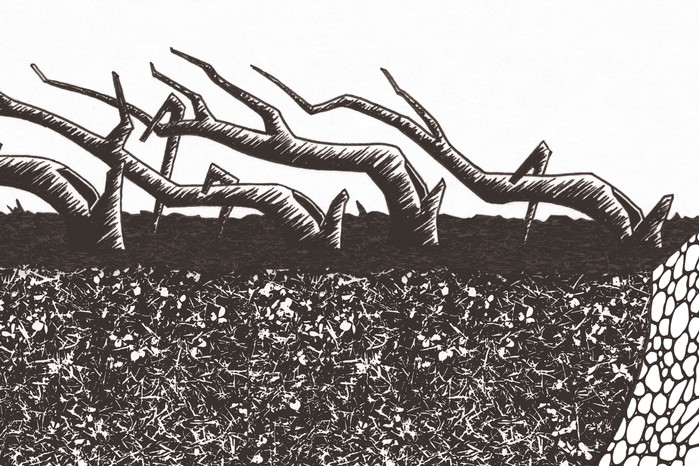
How to lay a hedge
Interested in the centuries-old skill of hedge laying? Follow our guide on how to lay a hedge and learn about the traditional ways to lay a hedge. Words Louise Allen, photography Andrew Montgomery, illustration Liam McAuley
Hedge laying is a country skill that has been practised for centuries. Although a well-laid hedge looks beautiful, the original aim was to create a fence to stop sheep, cattle and other stock from straying. Styles of hedges vary across the country (see below), but the principles of hedge-laying remain the same. By laying a hedge you not only create a living fence, you also help to encourage new growth, making it an excellent way of regenerating an old, overgrown hedge without replacing it. While initially quite tricky to grasp, it’s a skill that really is a case of practice makes perfect. Once laid, a hedge simply needs regular trimming to keep it in good order for decades – far longer than a wooden fence and infinitely more beautiful.
Don't miss our piece on alternatives to box hedging

How to lay a hedge
When is hedge laying season?
Hedge laying is a seasonal job carried out between October and March when trees and shrubs are dormant, and birds have finished nesting in the hedges. It is also the time of the year when many of the materials you’ll need for hedge-laying, such as the hazel and ash for the stakes and bindings that add strength and stability to the hedge, can be easily sourced.
A step-by-step guide on how to lay a hedge

First you need to remove the lower side branches from each stem, ideally using a pair of loppers (see here for our selection of hedging tools). This will allow light to reach the base of the hedge and encourage new growth, ensuring that the hedge thickens.

When cutting into the stem (or ‘pleacher’), you need to slice down at an angle just above ground level. Make the cut quite deep, far enough to allow the stem to bend over sufficiently for you to lay it down, but take care not to slice it all the way through.

Once you’ve made a cut in each stem, you can lay these down along the length of the hedge. You should never lay the stems completely horizontal as some upward slant is required to allow the sap to rise through the plant.

To add strength and stability to your hedge you will need to drive in a series of upright stakes, at intervals of around 50cm, along the whole of its length. These stakes need to be sturdy enough for you to hammer in, around 40-50mm thick, and cut to a length of around 1.6m. Hazel and ash are good woods to use, and you should be able to source stakes from a local woodland worker.

Bind the stakes firmly together, using long, thin and flexible hazel rods, known as binders, heathers or weavers. Ideally, these should be no thicker than around 25mm – the thinner they are the more flexible they will be for weaving – and around 2.5-3m long. Again, you can source these from a local woodland worker. Starting at one end, weave your binders around the tops of the stakes to hold the stakes firmly in place and add further strength. They also create a very attractive top to your hedge.

When your hedge is firmly bound, cut the cleft stumps (the stumps from the part of the stem not cut) down to just above ground level and be sure to leave them as clean and tidy as possible, as this is where regrowth is most desired.
Tools for laying a hedge
Traditionally, most hedge layers use a billhook for cutting through stems and branches. There are numerous different styles of billhook, which vary dramatically in weight and length. As with any tool, the feel of it in your hand is important, so it is worth finding a good tool supplier with a range you can try out for yourself. Vintage tools, such as those pictured below, can often be a good option.

- French loppers are the perfect tool for removing side branches.
- Yorkshire billhook is the preferred billhook for many professional hedge layers. It is generally larger and heavier than many other designs, making it ideal for cutting through bigger stems. It has a square-shaped, doubled-edged head and a short nose (the hook on the end).
- Pruning saws are ideal for cutting down cleft stumps.
- Nottinghamshire pattern billhook has some similarities to the Yorkshire pattern, with its distinctive double blade, but is smaller.
- Berkshire, or Moss pattern, billhook is smaller than the Yorkshire pattern, and offers a well-balanced blade and handle that is easy to use.
- Spar hook is a light and slim tool more commonly used by thatchers, but is also used by some hedge layers.
- Kent pattern billhook has a deeper blade than the Berkshire pattern, with a short nose that is useful for working at the bottom of a hedge.
Traditional county styles of hedges
Many different hedge-laying styles have evolved to reflect a region’s farming practices and its native trees and shrubs. Here are just a few:

Yorkshire
The Yorkshire style creates a very thin hedge. The hedge is cut close to the ground with plenty of thickness of material along the bottom; new shoots will grow from the already established root system. As with most hedge laying, the hedge is always laid uphill. Sawn stakes and rails are then used to finish the hedge. This method was adopted in Yorkshire because trees suitable for making stakes and binders did not grow well on windy uplands.

Devon
The Devon style hedge is normally laid on top of a bank. The pleachers, or steepers as they are sometimes known in the region, are laid much closer to the horizontal than the usual uphill angle, and are pegged down with crooked hazel sticks that are used to secure the hedge. The bank is an important element as this acts as the main barrier against livestock until the hedge develops.

South of England
In the South of England style the hedge is cut and laid over to create a double brush on both sides. A single line of hazel stakes are driven into the centre of the hedge, with the top bound with hazel binders. Both sides of the hedge are then trimmed immediately after the hedge has been laid. New growth from the base will keep it healthy and thick for years to come.

Midland
This is also known as the bullock style because it was traditionally used by farmers with large animals, where the hedge needed to be able to withstand the weight of cows pushing against it. Some would argue it is the most attractive of the hedge-laying styles. A combination of distinctive stakes and binders is used. The binders are woven along the top for maximum strength and the ends wedged behind the stakes.

Somerset
The Somerset style uses a row ofstakes that are driven in alternately on either side of the hedge. The stakes hold the pleachers in place, some of which are woven behind the stakes. Once the stakes are in place, any remaining branches, known as brash, are woven between the bent-over pleachers to give structure, thickness and sturdiness to the finished hedge.

Welsh Border
This method uses hazel stakes that are sometimes driven in at a 35-degree slant. Dead wood is used to protect the regrowth from being browsed by stock. The dead wood and live layers are woven along the centre line, with the top and side of the hedge being trimmed. Any large gaps should have new whips planted to fill the spaces. A few long, thin binders are then bound between the stakes.
More information
Find out more about the craft from the National Hedge Laying Society (hedgelaying.org.uk), which provides information on courses along with details of professional hedge-layers.
You can get a taste of the skill involved in hedge-laying at the annual National Hedge Laying Championship, where over 100 competitors enter eight regional styles to become supreme champion.
If it is more garden hedging plants you are interested in, check out our guide you are looking for a guide to the best hedging plants.
Suppliers
- A Morris & Sons Ltd. Tel 01647 252352. Small company that has been making billhooks and other tools since the 1800s.
- Carters, another small manufacturer making hand tools since 1740.
- Coppice Products. Tel 01952 432769. Provides details of local hedge-layers and locally sourced coppice products.
- Garden & Wood. Tel 01844 279170. Excellent range of vintage tools.
- Readyhedge. Wholesale nursery providing instant hedging and screening plants.
- Timeless Tools. Wide range of vintage tools.

Niwaki bundle worth £57 when you subscribe
Subscribe to Gardens Illustrated magazine and claim your Niwaki bundle worth £57
*UK only

Container Gardening Special Edition
The Gardens Illustrated Guide to Container Gardening.
In this special edition, discover colourful flower combinations and seasonal planting schemes for pots designed by leading plantspeople, and essential know-how for container gardening success. Just £9.99 inc UK p&pBy entering your details, you are agreeing to our terms and conditions and privacy policy. You can unsubscribe at any time.

Gardens of the Globe
From botanical wonders in Australia to tranquil havens closer to home in Ireland, let this guide help you to discover some of the most glorious gardens around the world
By entering your details, you are agreeing to our terms and conditions and privacy policy. You can unsubscribe at any time.




